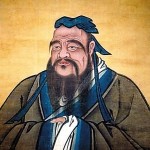Protection of the eco-environment is capturing wider international attention today. Eco-ethics and eco-philosophy have arisen in the face of the increasingly serious ecological crisis facing the whole world. Scholars in the field point out that human damage to the natural environment has accelerated to such an extent as to threaten the very existence of human beings themselves.
The main idea of eco-ethics and eco-philosophy is to replace “human-centrism” with “eco-holism,” which means that all living things in the earth’s biosphere are entitled to equal rights similar to those of human beings, or the rights to survival and development.
When we examine traditional Chinese culture, we also find from ancient times a strong eco-consciousness that is at one with eco-ethics and eco-philosophy.
The Philosophy of “Life”
Traditional Chinese philosophy is a philosophy of “life.” To Confucius, Heaven is the source of all living things. He regards the “creation of life” as the “Heavenly Way” and the “Heavenly Destination.” The Book of Changes (Yijing), following Confucius’ viewpoint, explains, “The continuous creation of life is change,” and “The great virtue of Heaven and Earth is creating life.” Mencius (c. 372-289 BC), a great Confucian scholar who lived just over 100 years after Confucius, said, “(One should) love one’s family, love the people, and love all living things in the world.” Confucian thinkers of later generations carried on the idea of “Heaven and Earth giving birth to all life,” and thus emphasized love for and kindness toward all living things. For example, many prominent Confucian scholars of the Song Dynasty (960-1279) echoed their master’s view on life. Zhou Dunyi (1017-1073) said. “Heaven creates life through yang and nurtures life through yin.” Cheng Yi (1033-1107) said, “The nature of life is love.” Zhang Zai (1020-1077) said, “All people in the world are my brothers and all beings in the world are my companions.” Cheng Hao (1032-1085) said, “Those with love regard themselves as the same as other living things in the world.” We can see from their thoughts that Confucian love starts from loving one’s family and other people, to loving all living things in the world. Humans and other living things are of the same kind and are equal with each other.
In a letter to his family. Zheng Banqiao (1693-1765). a great painter of the Qing Dynasty (1616-1911 ). wrote that he loved all living things in the world, be it an ant or an insect. This. he said, was the “will of Heaven,” and that human beings should understand Heaven’s will. He was strongly opposed to “keeping birds in a cage,” saying, “It is unreasonable to keep them in a cage just to please myself, to oppress their nature to suit my nature!” Even ferocious animals like wolves and tigers should only be driven away so they cannot harm people. People have no right to kill them at will. He went on to say that, if people really love birds, they should plant more trees as their home. When people rise in the morning and hear the birds singing, both would be happy. He described such a happy scene as, “(All living things) each live by their respective nature.” Only in this way could human beings share real happiness with their fellow beings.
Ecological Aesthetics
Related to eco-ethics and eco-philosophy is the eco-aesthetics of traditional Chinese culture. Ancient Chinese thinkers regarded nature, with human beings included in it, as the world of life. All living things in the world have their own life and state of being. “Life and its state of being is most worthy of appreciation,” said Cheng Hao. From such appreciation, people could draw the greatest spiritual delight, according to such philosophers. Confucian scholars in the Song and Ming dynasties all enjoyed observing “the state of being of living things.” Zhou Dunyi, for example, allowed the grass to grow in front of his window without cutting it. When asked why, he explained that the natural growth of grass was in line with his idea of living things. He “observed the creation of life and the state of being of living things in the world” through the grass. The state of being of the grass was similar to the state of being of people,, and the experience of this resemblance gave him great pleasure. Cheng Hao “fell great joy from observing living things.” He would often appreciate the fish he kept, and enjoyed watching newly hatched chicks. To him, the lively and lovely chicks best represented the “state of being.”
Humans at One with Other Living Things
Love for all living things in the world and appreciation for their state of being can often be found in ancient works of art and literature. Dong Qichang (1555-1636), a famous painter of the late Ming Dynasty, explained that, most artists enjoyed a long life because everything they observed was full of life. Dong You (birth and death dates unknown), collector and connoisseur of the Song Dynasty, emphasized that artists should depict the state of life, which exists in nature. Therefore, artists should observe and learn from nature. Wang Gai (1654-1710) of the Qing Dynasty summarized the secret of painting fish as: depicting their liveliness as they swim in water. He compared the happiness of fish in their natural world to the happiness of humans in their natural world. Chinese artists never paint dead animals. The birds, fish, insects, and flowers are all full of vitality under their brush.
Ancient Chinese literature has a similar focus. In the poems of the Tang and Song dynasties, when Chinese poetry reached the apex of development, birds and flowers were often depicted as if they had human feelings. In Strange Tales from Make-do Studio (Liaozhai zhiyi), by Pu Songling (1640-1715), human beings and other living things are described as being of the same kind. Many of the stories tell of love between men and beautiful women incarnated from plants or animals. “Xiangyu” is such a story. The heroines, Xiangyu and Jiangxue, are incarnated from, respectively, a peony flower and a camellia flower in a monastery on Mount Laoshan (sacred mountain of Daoism). Xiangyu falls in love with Huang Sheng, a scholar studying at the monastery. Jiangxue also becomes his friend. Unfortunately, a visitor to the monastery grows so fond of the white peony flower that he moves the plant to his home, where it withers up. The heartbroken Huang Sheng composes 50 poems entitled Crying over the Flower. Then the priests of the monastery want to cut down the camellia plant in order to build extra rooms there, but Huang Sheng stops them. Later, a new plant sprouts from where the white peony used to be. In his sleep, Huang Sheng dreams of Xiangyu begging him to water her every day. He follows her request. The plant grows more luxuriant day after day. The next year a large flower blooms, on which sits a tiny beauty. In a blink of the eye, the beauty floats onto the ground. She is none other than Xiangyu. The three of them live happily together. Later, Huang Sheng falls seriously ill. He leaves this message to an old priest, “You will find a red sprout growing vibrantly from underneath the white peony. It will grow into five leaves. That’s me.” The year after Huang Sheng’s death, a plump sprout indeed appears. The old priest diligently waters it. The sprout grows over three years to become a plant more than a meter tall, but it does not blossom. After the old priest dies, his disciple cuts down the plant because it never flowers. Soon afterward, the white peony plant dies, immediately followed by the death of the camellia plant.
“Xiangyu,” like many other tales by Pu Songling, is full of love for all living things in the world. These stories are to signify that humans and other living things are of the same kind, and they share weal and woe together.
Creativity and Exchange
Over a history of 5,000 years, Chinese people have produced numerous inventions. These include traditional Chinese medicine, silk, porcelain, the compass, paper, printing, and gunpowder. Some ancient landmarks also bear witness to Chinese people’s creativity, such as the Great Wall and the Forbidden City. At the same time, the Chinese people have always kept an open heart toward friends and cultures from other lands. The prosperity of the Tang Dynasty (618-907), for example, was largely due to Emperor Taizong’s (r. 627-649) open attitude toward the outside world. In the early Ming Dynasty (1368-1644), Emperor Yongle (r. 1403-1424) sent envoys to the Western Seas on seven long voyages. They reached as far as Mecca in West Asia and Mozambique in Africa. Wherever the Chinese travelers went, they carried out material and cultural exchanges under the principle of spreading peace.




发布产品咨询